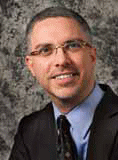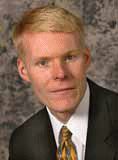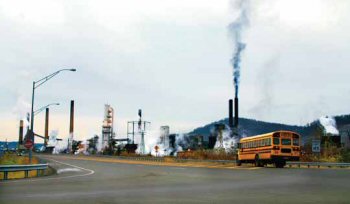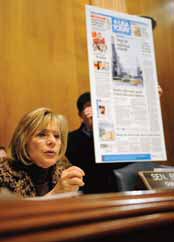SEJournal Online is the digital news magazine of the Society of Environmental Journalists. Learn more about SEJournal Online, including submission, subscription and advertising information.
By BILL DAWSON
 |
 |
|
Blake Morrison
|
Brad Heath
|
| Photos: Courtesy | USA TODAY |
"The Smokestack Effect: Toxic Air and America's Schools" was a USA Today series that won the Society of Environmental Journalists' 2009 Kevin Carmody Award for Outstanding Investigative Reporting. The newspaper provided this summary at the top of the web page for the project:
"USA Today used an EPA model to track the path of industrial pollution and mapped the locations of almost 128,000 schools to determine the levels of toxic chemicals outside. The potential problems that emerged were widespread, insidious and largely unaddressed. "
The SEJ judges had this to say:
"A team from USA Today led by reporters Blake Morrison and Brad Heath analyzed millions of government records, led a nationwide canvas of independent air monitoring, and investigated polluting industries near schools in an exhaustive and original reporting project that proved the air outside hundreds of schools was rife with toxic chemicals unknown to parents, school officials and health authorities. With impressive ambition and breadth, the team produced a report that is both national in sweep and chockfull of local details relevant to all 50 states. The team compiled tens of millions of government records about air toxics from more than two dozen sources into what Editor & Publisher called "one of the most extensive online database reports of any newspaper." The newspaper's series has led to a $2.5 million federal plan to systematically determine pollution levels outside schools."
Morrison and Heath jointly responded to emailed questions about the project from SEJournal's Bill Dawson.
Q: First, please tell me a little bit about yourselves: How long have you worked in journalism? How long at USA Today? What are your beats or assignments? What is your background in environmental and/or projects reporting? To what extent did you work together before this project?
A: Blake Morrison joined USA Today in October 1999. Before that, he worked at the St. Paul Pioneer Press in St. Paul, Minn. There, he covered a variety of beats, edited and worked as an investigative reporter. At USA Today, Morrison is the deputy enterprise editor and works on investigative projects. His experience covering environmental issues is limited, although one of his projects in St. Paul entailed high rates of mesothelioma among residents of Minnesota's Iron Range. The project raised questions about whether minerals in the soil might have behaved like asbestos fibers. Brad Heath is a national reporter at USA Today, where he specializes in data-driven enterprise and has covered subjects ranging from the aftermath of Hurricane Katrina to transportation safety and the Obama administration's economic stimulus plan. Before joining USA Today, he was an enterprise writer for The Detroit News and was the investigative reporter for The Press & Sun-Bulletin in Binghamton, N.Y. Morrison used to supervise Heath when Morrison worked in USA Today's News section. This is the first time the two teamed on a project.
Q: Air toxics has been an on-again, off-again issue for decades. I wrote a five-day series on the subject in 1986 for the Houston Chronicle and that was not the first major journalistic attention the topic had gotten in my part of the country. Why and when did you decide to do such an expansive investigation of this subject? Did something in particular — something you encountered in your earlier reporting, perhaps — plant the idea?
A: Morrison was exploring investigative ideas and had seen efforts by the Chronicle and other media to explore air quality. Many of those pieces looked at environmental justice issues — whether poor people bore the brunt of air pollution because low income housing, for instance, was located near industrial facilities. Morrison thought about whether USA Today might broaden those stories by looking at locations where the most vulnerable to pollution congregated: schools. Where were our schools relative to polluters? What might we be able to tell parents about what was in the air their children were breathing? As far as Morrison could tell, no one had done such an expansive story.
Q: Did you pitch the idea for the project to your editors or did it originate with one or more of them? If you pitched it, was it hard to persuade your bosses to devote so much time and expense to one subject? If it came to you as an editors' suggestion or assignment, what was your initial reaction?
A: Morrison pitched it in a 12-page proposal. He felt it was important to go beyond the notion of simply modeling pollution and take the broader step of monitoring outside schools ourselves. He met with scientists at Johns Hopkins and the University of Maryland and they embraced the idea. So too did the top editors at USA Today. They saw the value in its ambition and in its broad appeal. At that point, Heath was brought in. His data skills enabled us to create the interactive online database that enables parents to type in the name of any school in the nation to see what the best government data indicate is likely in the air outside.
Q: The SEJ contest judges admiringly cited your compilation of "tens of millions of government records about air toxics from more than two dozen sources" and quoted Editor & Publisher's description of your effort as "one of the most extensive online database reports of any newspaper." Tell me more about the scope of the work. For instance, how much time passed from the project's inception to publication? How many and what types of journalists and news organizations were involved? How many person-hours were devoted, if that's possible to estimate?
A: It was massive. We spent about eight months working on the project before the first story was published. In that time, we enlisted help from dozens of other journalists, both at USA Today and in Gannett newsrooms across the country. They are too numerous to count. Within USA Today, we teamed with photographers, web producers, programmers, editors, artists, designers, and others to craft our report and the online database that accompanied it. Beyond that, journalists in Gannett newsrooms from Detroit to Denver helped us gather air samples from outside schools. We have no idea how many hours that work consumed, other than to say it was a lot. Morrison and Heath basically worked on the project full time. The project's editor, Linda Mathews, oversaw the many moving parts. She helped organize the cadre of reporters and editors nationwide to help us take air samples at various locations.
Q: You worked with researchers at the University of Massachusetts in developing toxicity assessments for comparing the situations at thousands of different schools and with researchers at Johns Hopkins University and the University of Maryland on a methodology for monitoring the air around some of them. How did those partnerships come about? Were they difficult to arrange and pursue?
A: Morrison and Heath traveled to Massachusetts to meet with the researchers there. They had spent years — and quite a bit of money — to get raw data from the U.S. Environmental Protection Agency. That data — the basis of the EPA's Risk-Screening Environmental Indicators model — would become our foundation. The researchers there seemed intrigued by our idea. Essentially, we told them we wanted to overlay the locations of the schools onto the mapped data (which gave each square kilometer of the nation a "toxicity score"). Hopkins and Maryland scientists agreed to work with us at cost, constructing for us a monitoring protocol and then analyzing the samples that we sent them. It was important for us that Hopkins/Maryland took authority for the analysis. They were the experts and we wanted them to tell us what the samples showed.
 |
|
A school bus drives past the Mountain State Carbon coke plant in Follansbee, W.Va. In an exhaustive and original reporting project, a USA Today team revealed the air outside hundreds of schools was rife with toxic chemicals. The newspaper's series led to a $2.5 million federal plan to systematically determine pollution levels outside schools. © Photo by Garrett Hubbard, USA TODAY.
|
Q: You ended up ranking 127,800 schools according to relative impacts of air toxics nearby. In addition, you measured pollutant levels near 95 schools. Tell me about the process involved in translating the statistical information that you amassed into story decisions. Were some of the stories planned before the numerical results of your work were available, because you already knew the situations there were so compelling or representative of the problem?
A: Making sense of the numbers was one of the most challenging parts of our investigation. That was especially true with the EPA pollution model we used to rank the nation's schools. The EPA uses that model, called Risk-Screening Environmental Indicators (RSEI), to rank industrial sites based on how harmful their emissions are likely to be. It does that by producing a score that estimates the concentrations of particular chemicals in the surrounding area, and weighting them based on their relative danger. In other words, the model gives you a number that tells you one place is likely worse than another, but is not based on any unit or measure, so it has little real-world meaning. There is no standard for deciding when a score is too high. Searching for one, we consulted with dozens of scientists, engineers, and government officials; Heath attended a conference of RSEI users. In the end, we settled on one approach: We compared schools' rankings in the model to the ranking of an Ohio elementary school that was shut down in 2005 after air samples collected on its roof showed carcinogens in the air at levels 50 times higher than what the state considers acceptable. We found 435 schools where the model suggested air pollution was even worse
Those results were indispensable. They shaped much of our reporting, guided our decisions about air monitoring, and helped us identify the stories we could tell.
Translating the results of our air monitoring was easier, mostly because the scientists with whom we partnered do this every day. We depended heavily on their expertise. We gave them the samples, and when they came back with a report, we asked them to tell us what the numbers meant. They gave us a simple framework: In a few schools, they said, the results were troubling: the concentration of at least one chemical was high enough that people could be harmed if they were exposed over a long period of time. At many more, they said, elevated levels suggested a need for additional testing.
That reflects the conclusion we reached early in this investigation that we would never be able to say definitively whether the air is safe. Even the best models are only estimates, and our air monitoring, while extensive, offered only a snapshot of what was in the air. Rather, we used both tools to identify places where the best data available raised enough red flags that people should want to know more.
Q: How did you choose the 95 schools where pollutants were monitored?
A: We based our choices mainly on the rankings we had produced from the EPA's pollution model. In doing so, we were careful not to select only the schools where the model suggested air pollution would be worst. Rather, we made sure our selections included some of the schools that ranked among the best for likely exposure to toxic pollution, and others that ranked among the worst. Because the monitors we used in most locations could detect only a fairly narrow set of pollutants, we also focused on the particular chemicals the model indicated were likely to have been in the air. To the extent we could, we focused on schools where the model suggested the presence of chemicals we'd actually be able to detect.
Practical considerations also played an important role. We did most of our monitoring in places where USA Today has bureaus, or where our parent company, Gannett, operates other newspapers or television stations. That let us rely extensively on our colleagues from across the company. When we conducted more intensive tests — samples to measure metals and other chemicals, which required that equipment be checked daily — we tried to pick clusters of schools that were all within a day's drive of one another.
Q: Describe the public — as distinct from governmental — reaction to your findings. For example, was the response different in different parts of the country? Have you tracked the extent to which people have used the database and what they may have been prompted to do because of what they learned?
A: The public reaction has been astounding. One advocacy group set up a template to help track letters sent to Congress that cited our work and called for guidelines on school siting; in the first weeks alone, thousands of letters were sent. We received hundreds of emails from readers who wanted more information. Some, such as Mary Peveto in Portland, Ore., now lead ad-hoc environmental groups that are seeking answers from local industries and regulators. She cited our stories and database as the catalyst. In the first weeks after we published, we had more than 1.2 million page views on the database. We suspect we've had tens of thousands more since.
 |
|
At the Senate confirmation hearing last January, Sen. Barbara Boxer (D-CA) asked about toxic industrial emissions near schools, the subject of USA Today's series, "The Smokestack Effect," displayed at the hearing. © Photo by Jack Gruber, USA TODAY.
|
Q: Regarding the governmental response, a couple of questions: How closely have you been continuing to track the initiative undertaken by the EPA because of your work? Also, please give me an idea about the governmental response at the local and state levels that you're aware of. Have you been reporting on these state and local developments, or is that up to your colleagues at affiliated news organizations?
A: We've closely tracked most of the monitoring that has been done since we reported. The U.S. EPA launched a $2.25 million program to monitor the air outside 63 schools in more than 20 states. We've reported what they've found — in some places, high levels of chemicals such as manganese and acrolein. The EPA has been exceedingly transparent about what its regulators are finding, what the limitations of the findings are, and what further action is necessary. State regulators have handled matters differently. In Louisiana, for instance, regulators visited one school located about six blocks from the nation's second-largest oil refinery. EPA data showed the school ranked in the worst 1 percent for air quality, and USA Today tests nearby bore that out. But we spent only about four days testing, something that Hopkins explained as being more illustrative than definitive. Louisiana regulators did far less than we did there. In fact, they took a grab-sample — a few hours' worth of air on a single day. They say they found nothing and subsequently declared to residents that all was well. In Pennsylvania, we found high levels of chromium outside a school. When we sampled, the nearby steel mill was operating. When Pennsylvania regulators sampled, it wasn't. They didn't find high levels of chromium, and to our knowledge, they have no plans to return to take measurements when the plant is operating at full capacity.
Q: Of all the findings produced by your research and reporting, of all the things you learned, what surprised you the most?
A: How little the U.S. EPA knew. The agency had the model. It had the data. It even had an office for children's health protection. Yet for some reason, officials seemed disinterested in what we were undertaking. One, the former head of the children's health protection office, told Morrison that it wasn't her responsibility. It became the agency's responsibility after Lisa Jackson became administrator, and the tone at the EPA has changed dramatically since.
Q: Few reporters ever have the kind of resources you were able to marshal on "The Smokestack Effect." Still, are there some lessons you learned in producing the project that might be instructive for other journalists embarking on investigative work of their own — in the environmental arena or otherwise?
A: Three big lessons. First, think big. Do something people haven't tried before, even if it feels overwhelming at first. Second, enlist experts. We sought people who knew more than we ever will about testing, for instance. Third, look for ways to ensure your work can make a difference. We explained what we did to anyone willing to listen — from local groups and regulators to EPA officials to staffers with the Senate Environment and Public Works committee. The staffers, for instance, pushed the issue forward in Congress and were largely responsible for persuading the EPA to embark on the $2.25 million monitoring effort.
Bill Dawson is assistant editor of the SEJournal.
** From SEJ's quarterly newsletter SEJournal Winter 2009-10 issue













 Advertisement
Advertisement 



